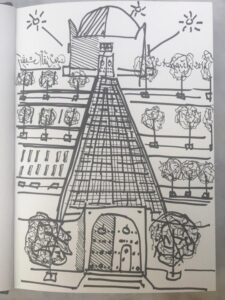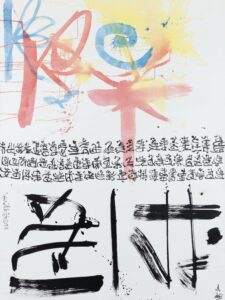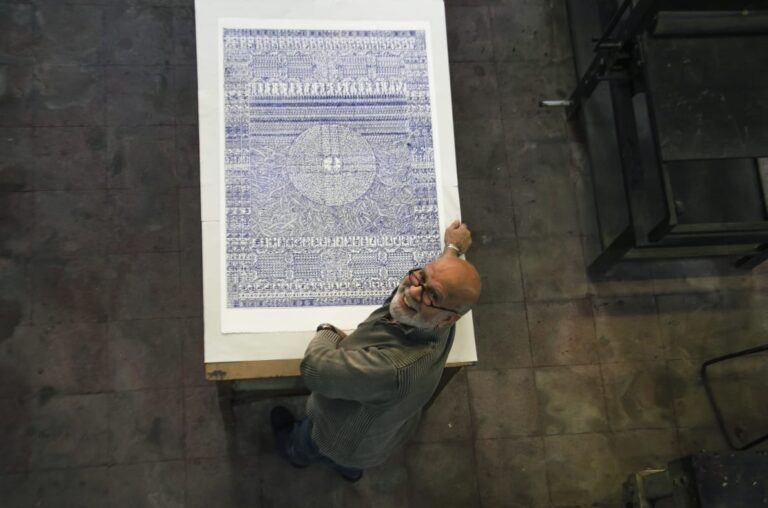30 Artists, 30 Years – Rachid Koraïchi
Interviewed by Isabelle Caussé, art curator, Bagri family collection – May 2020
IC: Your work is in the Bagri family collection and currently on display on the walls of the Bagri Foundation whose focus is to promote Asian arts. On your side, I know you have done a lot for African art. Can we have your thoughts on the importance and perhaps ways of raising awareness of the arts of a region?
RK: I am pleased to hear my work is on display at the Bagri Foundation. Recently I spent quite a bit of time in Asia notably Pakistan where my work was at the National Museum in Lahore part of the Biennale. I also took this opportunity to create a work there. It is a large etching that I made with a wonderful local team. The transfer of my drawing onto the metal plate for example happened on a rooftop in the midst of a very busy souk thanks to the sun and a man who had such knowledge of what he was doing.
I think for works to be shown and shared across continents in large international events such as museum exhibitions, biennales, fairs etc. is very important. For African contemporary art this has been slow but it now is moving in the right direction thanks to a few individuals and the support of some Art Foundations particularly American ones. As an artist I also believe it is important to travel and work across continents as a means of gaining and promoting a deeper understanding of art.

IC: You once said “mon atelier est le monde” (my studio is the world) – even today, as we launch into this interview and you are confined in Barcelona in the midst of Covid-19, you mention having just set up four mask making workshops in four different countries – including one in Iraq with father Najeeb renowned for his work on the protection of Iraq’s cultural heritage. You truly have found a way of life and working above borders. Could you explain what guides you?
RK: The human is what has always guided me. I admire the work and dedication of father Najeeb whom you mention. In 2015 I also launched into a manuscripts’ preservation project. It is in Dagestan where I traced back part of my family, the Koraïchi, direct descendants of Prophet Mohammed. Part of the family went from Mecca to Africa while another ended up in Asia as far as present-day Dagestan.
In my work I always look for ‘savoir-faire’ (know-how). For example, in 2001-2 I did a project in Syria, called 7 Variations autour de l’Indigo (7 Variations of Indigo), with highly skilled silk makers of Aleppo. Their knowledge dates back to centuries ago and is very comprehensive, from the cultivation of silkworms to making the garments.
I currently have ateliers in Cairo, Madrid, here in Barcelona where I do ceramics, Tunisia and Paris. My workshops are where I discovered specific know-how. I admire craft and craftsmen. In Egypt I work with Egyptian cotton, again with artisans who have extraordinary knowledge. My work in these places has now come to a stand-still but I am pursuing my work – I draw.
My project in Tunisia is called Jardin d’Afrique. It is a cemetery, though I prefer to call it a garden, for all the bodies found on the shores of Tunisia. There was no room for them in local cemeteries so I purchased land and designed a ‘garden’. My hope is that in the future families can come and pray here. This on-going project is very important to me. I hope that it will bring people together, bridge borders. At the moment we have many African refugees but also Syrians and Bangladeshis to be buried. The work is being done with local craftsmen – ceramists, metal and woodworkers, stonemasons etc. – and local knowledge for aspects such as the plants and trees we will have.

IC: Can you tell us more about your art projects in Asia and what these experiences might have brought you? Any plans or wishes to build on these experiences?
RK: I have already mentioned Syria and my silk work there which was a very rich experience. I later returned to Syria for my project Jardin d’Orient at the Chateau d’Amboise in France. I then worked with highly skilled Syrian stone and bronze artisans.
Going further East, I had the chance to meet and work with now deceased Japanese living treasure Maître Akeji. Together we created ‘four hands’ pieces. A publication came out of our time and work together. It was a truly enriching experience. Of course, I always would welcome such meetings and collaborations, in Asia and elsewhere. The art of writing is very important to me as it is for many Asian artists. When in Pakistan recently I passed the pigeon house that sits at the centre of Istanbul Square. It also made me think that I would love to design a birdhouse using the regional red bricks which I find beautiful.
Biography
Born 1947 in Ain Beida, Algeria. Koraïchi’s work is influenced by a heritage in intellectual Sufism and an early schooling as Quraishite- transcriber of Quranic texts- in the Aurés region in Algeria. Drawing on Arabic semiotics and dwelling on calligraphy as a means of interpretive transcendence, Koraïchi’s work utilizes letters and signage to evoke figurative imagery and enumerate universal messages to a global audience. Koraïchi engages local artists and craftsmen trained in antiquated traditions to craft artifacts for site-specific installations that foster dialogues between local and global communities. His work has been featured in several international exhibitions such as the 47th and 49th Venice Biennials as well as a major installation, Path of Roses, at the Emirates Palace in Abu Dhabi. Koraïchi is based in France and works across Algeria, Tunisia and Egypt.


